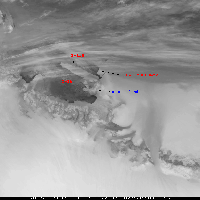Ross Ice Shelf Breaks, As Expected—Big Berg Loosed
 Madison, WI, May 10, 2002—A new iceberg has calved from the Ross Ice Shelf. C-18, the small iceberg found on May 5, may have enlarged a crack already in the ice. The shelf has cracked along its length, and its front section has separated from Antarctica.
Madison, WI, May 10, 2002—A new iceberg has calved from the Ross Ice Shelf. C-18, the small iceberg found on May 5, may have enlarged a crack already in the ice. The shelf has cracked along its length, and its front section has separated from Antarctica.
The new iceberg is partially obscured by cloud on the first satellite image that shows it. If the iceberg is all one piece, it is about as long as the current B-15-A, roughly 200 km (about 125 miles) long.
At the University of Wisconsin-Madison’s Space Science and Engineering Center, researcher Linda Keller (Department of Atmospheric and Oceanic Sciences) noticed the break while posting daily images on the Web site of the Antarctic Meteorological Research Center (AMRC). The center is funded by the National Science Foundation to make available daily composite images from weather satellite data. AMRC also monitors icebergs, by Matthew Lazzara (co-investigator for the AMRC), Linda Keller and others, and has tracked the large iceberg B-15 since it calved in March 2000.
Emeritus Professor Charles Stearns is Principal Investigator for the AMRC, and has studied and visited the continent for decades. He noted, “That crack has been there about as long as people have been going to Antarctica. In 1987, I saw it from an icebreaker.” He explained that the edge of the ice moves down from the high Antarctic plateau covering most of the continent at the rate of a kilometer a year and is fed by glaciers and ice streams. The ice is 2000 to 4000 meters thick on the plateau. It slowly moves down to the ice shelves, at the edges of the continent, where it gradually sloughs off, or calves, in the form of icebergs.
The chunk now calving from the Ross Ice Shelf has been moving for 30 years, Stearns noted. He added, “Ice flows down hill, feeding the ice shelf. It would pile up if it did not break off.” This latest calving brings the Ross Ice Shelf to the size it was in about 1911, when Scott’s team first mapped it.
Since the current crop of calving events (icebergs being born are called calvings) began in March 2000, Antarctic researchers have worried about possible impacts on shipping in the southern oceans. The concern continues with one more super-size iceberg broken free.
Keller notified the National Ice Center, which announces new icebergs, of her discovery. They have named the new iceberg C-19.
When the AMRC receives reasonably clear images of the icebergs, they are posted on the Web site.
A technical paper on iceberg calvings is available in Polar Geography, 1999, No. 3, by M. Lazzara, K. Jezek, T. Scambos, D. MacAyeal and C. van der Veen.
Contact:
Matthew Lazzara, SSEC, 608-262-0436
SSEC’s Public Information Officer, SSEC, 608-263-3373
